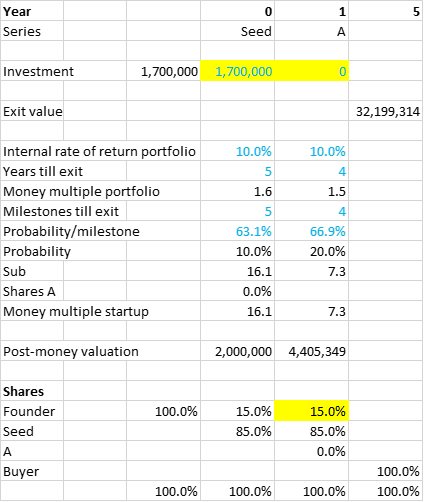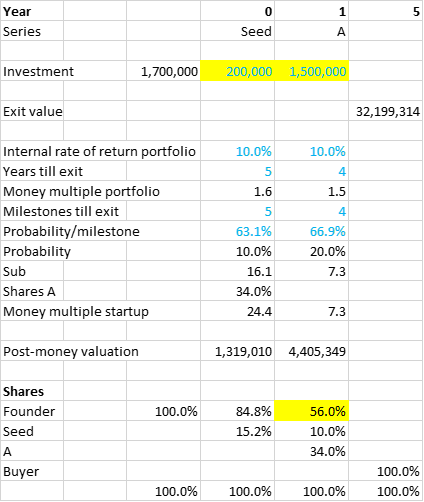Raising money isn’t easy. Some startup founders therefore want to get funding once, and be done with it. Is this smart? Joachim Blazer finds out.
Raise 1 round
Have a look at the following calculations.

-Where does my cash curve bottom out? Assume at -/- $1.7m. So I need to raise $1.7m.
-What is my exit value? Assume $32.2m.
-What internal rate of return (IRR) does a Series-Seed investor want to make on his portfolio? Assume 10.0%.
-When will the series-seed investor sell his shares? Assume after 5 years.
-A 10.0% internal rate of return on his portfolio and 5 years till exit means the series-seed investor has to make a 1.6x money multiple (MM) on his portfolio.
-How many milestones do I have to achieve between Series Seed and exit? Assume 5 milestones.
-What is the probability of success per milestone? Assume 63.1%.
Five milestones with a 63.1% probability per milestone result in a 10.0% probability of success for my startup at the time I raise a series seed.
A 1.6x money multiple and a 10.0% probability results in a 16.1x money multiple for my startup.
A $32.2m exit value and a 16.1x money multiple result in a $2.0m valuation.
A $1.7m investment at a $2.0m valuation means I must issue the series seed investor 85.0% new shares.
Raise 2 rounds
Now let’s compare this to two rounds:

-I need to raise $1.7m.
-How much money do I need to achieve my first milestone? Assume $200k.
-And my second milestone? Assume $1.5m.
Series A
-What internal rate of return does a series A investor want to make on his portfolio? Assume 10.0%.
-When will the series A investor sell his shares? Assume after 4 years.
A 10.0% internal rate of return on his portfolio and 4 years till exit means the series A investor has to make a 1.5x money multiple on his portfolio.
-How many milestones do I have to achieve between series A and exit? Assume 4 milestones.
-What is the probability of success per milestone? Assume 66.9%.
Four milestones with a 66.9% probability per milestone result in a 20.0% probability of success for my startup at the time I raise series A.
A 1.5x money multiple and a 20.0% probability results in a 7.3x money multiple for my startup.
A $32.2m exit value and a 7.3x money multiple result in a $4.4m valuation.
A $1.5m investment at a $4.4m valuation means I must issue the series A investor 34.0% new shares.
Series seed
Because I issue the series A investor 34.0% new shares, I must correct the series-seed money multiple to 16.1x / (1 – 34.0%) = 24.4x. Otherwise the series seed investor will not achieve his target internal rate of return because of dilution.
A $32.2m exit value and a 24.4x money multiple result in a $1.3m valuation.
A $200k investment at a $1.3m valuation means I must issue the series seed investor 15.2% new shares.
2 rounds is the way to go
If I raise $1.7m in 1 round, I end up with 15.0% of the shares. Oomph. That’s not good. Then I might just as well become an employee somewhere.
If I raise the same $1.7m investment in 2 rounds, I end up with 56.0% of the shares. That’s more like it.
Fun fact
Even though my series seed valuation is lower ($1.3m instead of $2.0m) I end up with more shares. Go figure.
Thanks to Hans Westerhof and Chretien Herben.
 Joachim Blazer is a corporate finance advisor. He helps founders raise money. Contact him at hello@joachimblazer.com. The original article appeared on his blog first.
Joachim Blazer is a corporate finance advisor. He helps founders raise money. Contact him at hello@joachimblazer.com. The original article appeared on his blog first.
Image: ErikaWittlieb @ Pixabay
